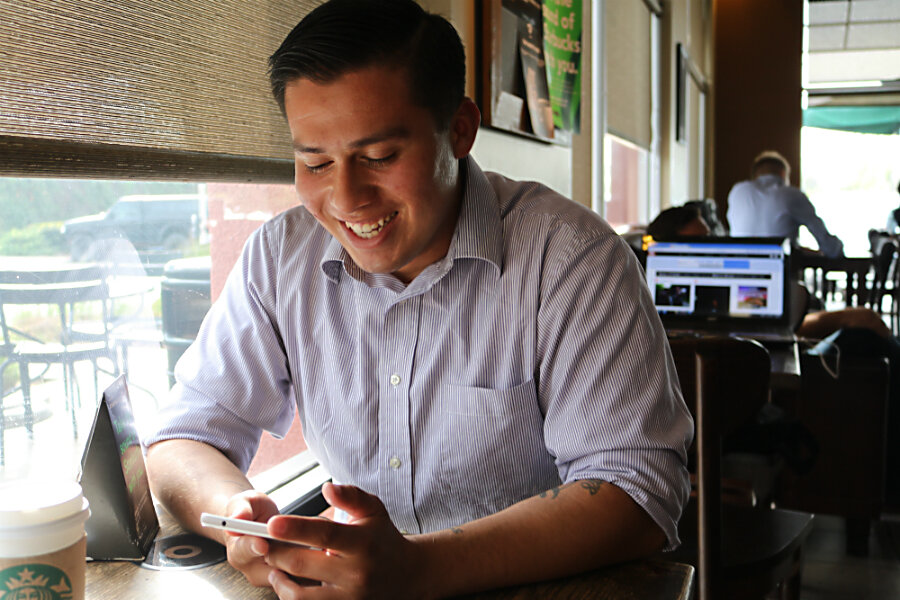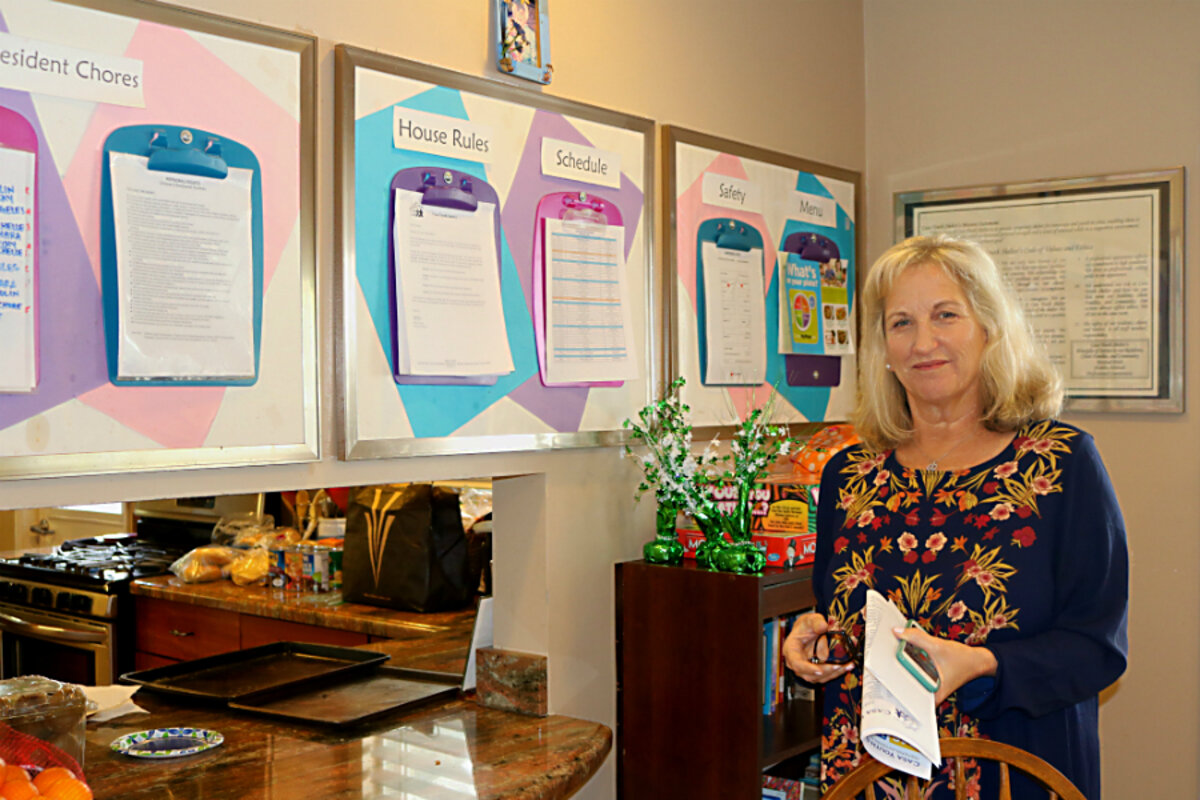California's two different visions for better foster care
Loading...
| Los Alamitos, Calif.
Alberto Gutierrez had been off the streets and living at a youth shelter in Los Alamitos, Calif., for about a year when, for the first time in his life, he found himself nursing a broken heart. His girlfriend of nearly two years – someone who had helped see him through the horror of being homeless – had cheated on him, he learned.
“I felt like I had been stabbed in the chest,” says Mr. Gutierrez, who was 15 at the time. “I started crying. I needed a hug.”
Thankfully, he says, Kathleen Cyr, a senior staffer at Casa Youth Shelter, where Gutierrez was then living, was happy to oblige. To a boy with few friends, a rocky relationship with his stepfather, and a mother fighting a heroin addiction, that bit of comfort meant the world, says Gutierrez, now 18.
“It’s kind of like a family. They support you,” he says at a coffee shop in Orange, Calif. “The staff is like family to you.”
In a push to reform child welfare systems, California and other states continue to move toward placing children with foster families instead of in group homes. The ongoing shift – backed by research that finds most children thrive in traditional family settings more than they do in congregate care – has been spurred by reports of abuse, mismanagement, and exploitation at group homes and shelters for troubled youths in the state and elsewhere.
But Gutierrez’s experience presents an additional narrative – one that suggests that long-term placement in particular kinds of group homes deserves further consideration by policymakers and advocates, some child welfare researchers say.
“I’m concerned about the direction California is headed,” says Bethany Lee, an associate professor at the University of Maryland School of Social Work in Baltimore. “I think certainly there’s a very strong ideology that every kid needs a family – that’s hard to argue with.”
But, she adds, “there’s always been a shortage of good homes for kids, and when we think of kids in the child welfare system, they have higher levels of trauma, higher needs. That’s not something families always want to sign up for.”
Of the more than 415,000 children in the foster care system nationwide in 2014, about 75 percent lived with foster families, according to data from the federal Adoption and Foster Care Analysis and Reporting System (AFCARS). About 14 percent – or more than 56,000 children – were housed in group homes or institutions, for reasons that range from severe mental and behavioral issues on the part of the child to difficulty finding a suitable foster family on the part of the participating agency.
If reforms at the state and national levels move forward, many such facilities may be forced to cut costs, reduce the amount of time they can shelter children, or close down, Professor Lee says. “If there aren’t other opportunities for kids who don’t want to live in a family or aren’t successful with families,” she says, “that can be a problem.”
The case against congregate care
The California child welfare system has more than 62,000 children – the most of any state.
Last October, California Gov. Jerry Brown (D) signed a bill that phases out the way group homes in the state currently provide treatment and services in favor of measures that aim to give more support to foster families.
Among the major changes: the creation of short-term residential treatment centers that would focus on “specialized and intensive treatment” for up to six months for children who demonstrate a high level of need. Longer stays would require the approval of a senior county welfare director.
The bill, which received broad bipartisan support, would also direct more resources toward recruiting foster families, as well as providing them with treatment, therapy programs, and wraparound services. Those services involve a team of family members, agency representatives, and service providers collaborating to develop and implement an individualized plan of care for a child.
The measure takes into account a California Department of Social Services report, issued in January 2015, detailing the need for greater emphasis on placing children with families, and providing increased support to the families who are willing to care for such children. While foster families are far from perfect – foster parents have been known to abuse or neglect children in their care, or take in children solely for the stipend – the bill also reflects research that shows reuniting children with families, or placing them in environments that closely resemble the traditional family setting, reduces the trauma of being pulled out of their own homes.
“The policy is now aligned with what development [research] says we have to do, what we know children need,” says Jennifer Rodriguez, executive director of the California Youth Law Center (YLC), a San Francisco firm that provides legal services to children in the foster care and justice systems.
“There might be really extreme cases where youth are having a serious mental health crisis where they need some short-term treatment, and they can only be safe in a congregate setting,” she adds. “But they should be coming from a family, the family should be involved in treatment, and [they should be] exiting to a family.”
Ms. Rodriguez would know: After her father went to jail and her mother was diagnosed with paranoid schizophrenia, she lived on the streets and was picked up by police for everything from shoplifting to prostitution. Shortly after she entered the foster care system at age 12, Rodriguez was told that her history made her unfit for a foster family. She bounced between institutions until she aged out of the system at 18.
“How is it ever OK for any child to be told that they don’t deserve a family?” Rodriguez asks. Now a mother herself, she stands by the notion that “the key part of treatment is the parenting,” she says. “It’s not going to the groups or talking to a therapist for 60 minutes.”
Also contributing to the urgency with which the California government has approached foster care reform are allegations of abuse at group homes. Over the past year, the Los Angeles Times and ProPublica conducted separate investigations of group homes in L.A. County that catered to the most emotionally troubled and marginalized youths in the foster care system. Both papers found a number of cases of neglect, exploitation, and even sex trafficking.
“Kids need relationships with individual, caring adults, not with [staff members on] shifts,” notes Carole Shauffer, senior director for strategic initiatives at the YLC. “So although group homes could be necessary for treatment, it’s not a way to grow up.”
A need for options?
The low, two-story structure that houses Casa Youth Shelter in Los Alamitos – a small city in Orange County – stands in contrast to the picture of group homes painted by the Times and ProPublica reports, looking more like a large family residence than a facility.
Brick-red shingles cover the roof, and a welcome sign – “Bienvenidos” – adorns the front door. Inside, staff members sit around one of three dining tables in the kitchen, waiting for their teenage charges to finish a morning group session, held in the courtyard outside. Beyond, a hallway leads to the bedrooms and the stairway to the second floor, where a game room dominates the space.
The place is set up to convey comfort to its young residents, aged 12 to 17, says Robin Sinclair, the shelter’s executive director.
“There are group homes that are more institutional. This is not at all like that,” she says. “[The kids] know when they come here, they are cared for.”
To Ms. Sinclair, the state’s push toward giving every child a foster home until the child is either reunited with family or adopted is well intended and understandable. But, she says, there remains a shortage of families willing and able to take in children whose home situations have become untenable or abusive, or who have nowhere to go.
Indeed, in neighboring Los Angeles County, the number of beds in homes of nonrelative foster parents dropped from 22,000 in 2000 to 9,000 in 2015, the Los Angeles Times reports. The county is home to about a third of the more than 62,000 children in California's child welfare system.
The gap between supply and demand makes places like Casa – whose percentage of private funding allows it to receive children from all over the region – critical to an overburdened child welfare system, Sinclair says.
“I get what the government is trying to do, but the reality is just there are not that many [foster homes] out there,” she adds. “This legislation would completely disrupt what we do here.”
At Casa, as in any foster care agency and facility, the goal is to reunite troubled children with their families whenever possible. In the interim, the home provides 24-hour shelter, meals, and a structured schedule that involves everything from chores to family therapy sessions to intensive individual counseling. Staff members pitch in to take residents to school and to things like dentist appointments.
Most residents stay for one to three weeks. Four beds are reserved for extended placements like Gutierrez, who stayed for about two years.
While the home’s small size can be limiting – 12 beds total – it also allows staff members and counselors to make each child feel loved and welcome, Sinclair says. And though Casa is not a replacement for a safe, caring, two-parent household, she adds, “it comes pretty darn close.”
Gutierrez today credits his time at Casa for helping him reconnect with his stepdad and set goals for himself. He hopes to attend Santa Ana College in the fall.
Mixed bag
For some who study foster care, the issue is not about whether a foster family or a group home is the better choice in general, but about deciding what kind of placement might work best for a particular child. Such a decision would require a more thorough assessment of each child at the time he or she enters foster care than the system currently provides, says Astrid Heger, a professor of clinical pediatrics at the University of Southern California’s Keck School of Medicine in Los Angeles.
“There is a sense that we can create a system to recruit and keep foster families with the qualities needed to support a child becoming a productive secure adult. However, we have assumed that just placing a child in a home where they are compensated to ‘care’ for the child is enough to create this quality environment,” writes Professor Heger, who is also executive director of the Violence Intervention Program at the Los Angeles County-USC Medical Center, in an e-mail.
“By not assessing the child at the time of detention and working to create a support system for each family, whether it is kincare or foster care ... the group home [and] congregate care setting are seen as warehouses” where children cycle in and out, unable to find permanence, she continues.
Others acknowledge that the issue of providing the best kind of care for troubled, traumatized young people is an enormous challenge that requires further investigation by policymakers and researchers – even as agencies move forward with trying to address current problems.
“We need to think about the question of who works for whom, and what do high-quality group homes look like, and what does a high-quality foster family look like,” says Lee at the University of Maryland. “That’s really where the research should be right now.”
In the meantime, she says, “I think states will be watching California to see ... what will happen.”







